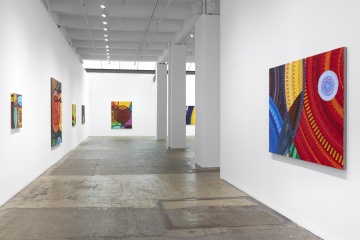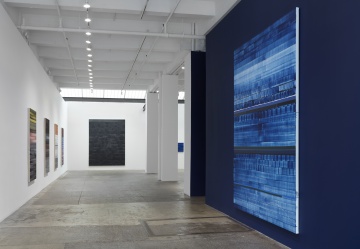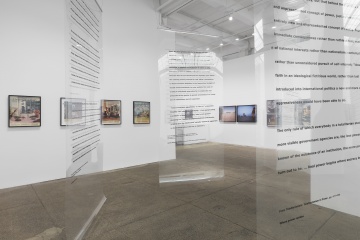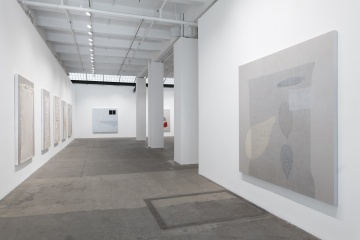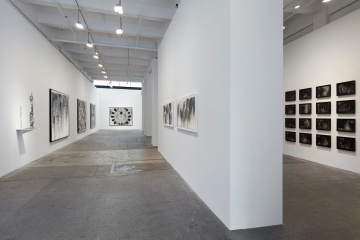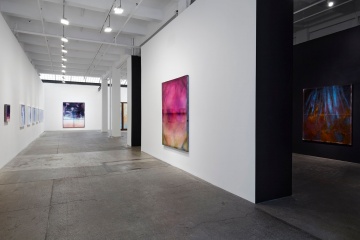Galerie Lelong & Co.
528 West 26th Street
New York, NY 10001
212 315 0470
New York, NY 10001
212 315 0470
Galerie Lelong opened in New York in 1985, and in 2001 moved to its present (ground-floor) location in Chelsea. The gallery’s focus is in international contemporary art, representing artists and estates from the United States, South America, Europe, and the Asia Pacific region.
The gallery has a long history of working closely with museums and public institutions from around the world to support the placement of permanent commissions and the creation of monographic exhibitions and publications on its artists. It has been a proponent of contemporary Latin American art and has presented exhibitions by some of its most vital figures for over two decades.
Artists Represented:
Etel Adnan
Etel Adnan
Elda Cerrato
Petah Coyne
Leonardo Drew
June Edmonds
Angelo Filomeno
Ficre Ghebreyesus
Andy Goldsworthy
Sarah Grilo
Jane Hammond
Alfredo Jaar
Rosemary Laing
Lin Tianmiao
Nalini Malani
Alice Trumbull Mason
Cildo Meireles
Yoko Ono
Jaume Plensa
Zilia Sánchez
Pinaree Sanpitak
Kate Shepherd
Tariku Shiferaw
Nancy Spero
Michelle Stuart
Pamela Phatsimo Sunstrum
Mildred Thompson
Barthélémy Toguo
Juan Uslé
Ursula von Rydingsvard
Krzysztof Wodiczko
Catherine Yass
Works Available By:
Hélio Oiticica
Ana Mendieta
Carolee Schneemann
Chris Watts

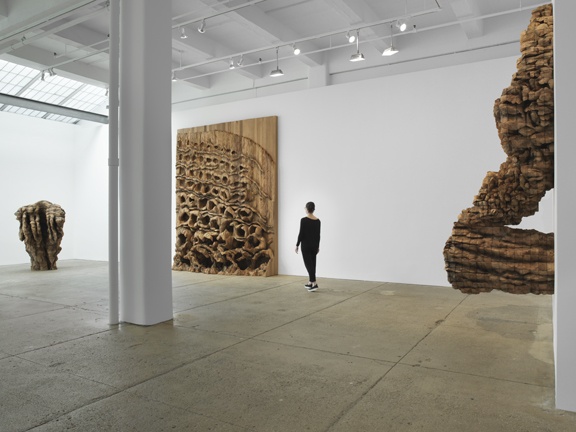
Installation view: LEONARDO DREW, Galerie Lelong & Co., New York, May 16 - August 2, 2019
Installation view: Ursula von Rydingsvard: TORN, Galerie Lelong & Co., New York, May 3 – June 23, 2018
June Edmonds
The Sky Remains the Same
September 4, 2025 - October 25, 2025
Galerie Lelong, New York, is pleased to announce a solo exhibition by Los Angeles-based artist June Edmonds, the artist’s first major solo exhibition in New York. The exhibition will present new paintings that derive inspiration from the ebe-amẹn, or river leaf, motif. Having long grounded her practice in the research of important events and traditions in Black American art and history, Edmonds recontextualizes the historic, sacred geometric form originating in the Kingdom of Benin for this body of work. Entitled The Sky Remains the Same, the exhibition considers the power of inner strength as an enduring constant through changing perspectives, patterned impasto, and a vibrant, psychologically charged palette.
Image: Installation view, Galerie Lelong, New York, June Edmonds: The Sky Remains the Same, September 4 – October 25, 2025. Courtesy Galerie Lelong, New York. Photo: Thomas Müller.
Etel Adnan, McArthur Binion, John Clang, Petah Coyne, Ficre Ghebreyesus, Sarah Grilo, Alfredo Jaar, Rosemary Laing, Lin Tianmiao, Yoko Ono, Jaume Plensa, Martha Rosler, Tariku Shiferaw, Nancy Spero, Michelle Stuart, and Krzysztof Wodiczko
Summer Reads
June 26, 2025 - August 1, 2025
Galerie Lelong, New York, is pleased to announce the upcoming group exhibition Summer Reads, featuring artists Etel Adnan, McArthur Binion, John Clang, Petah Coyne, Ficre Ghebreyesus, Sarah Grilo, Alfredo Jaar, Rosemary Laing, Lin Tianmiao, Yoko Ono, Jaume Plensa, Martha Rosler, Tariku Shiferaw, Nancy Spero, Michelle Stuart, and Krzysztof Wodiczko. Organized by Grace Hong, Assistant Director at Galerie Lelong, New York, the exhibition largely draws from the gallery's international program and features activations from an ongoing performance series by John Clang. Summer Reads invites visitors to ponder the act of reading in contemporary art, exploring the role of source materials across literature and how the legibility of material informs artmaking.
Juan Uslé
CIEN DIAS DE ABRIL
May 15, 2025 - June 21, 2025
Galerie Lelong, New York, is pleased to announce an upcoming solo exhibition by Juan Uslé, CIEN DIAS DE ABRIL, the artist's second with the gallery. The exhibition will present new paintings through which the artist advances his exploration of rhythmic abstraction, creating compositions that register the passage of time and invoke a sense of place, producing works that are at once deeply personal and universally resonant. This exhibition will be followed in October 2025 by a major retrospective at the Museo Nacional Centro de Arte Reina Sofía, Madrid, Spain.
Uslé's distinctive approach centers on rhythmic, short brushstrokes arranged in bands of shimmering color. By shifting between opaque and transparent passages, he generates a dynamic sense of movement across the surface. Beyond their formal qualities, the titles of his works—such as Breathing Earth, Partitura urbana [Urban Score], 21 días de abril [21 Days of April], and Transitum [Transition]—offer insight into the poetic and conceptual undercurrents of his practice. For Uslé, painting becomes a vessel for sensorial experience and memory, with each work serving as a container of lived time that can be both past present and future, expressed clearly in the mysterious title, CIEN DIAS DE ABRIL.
Image: Installation view, Galerie Lelong, New York, Juan Uslé: CIEN DIAS DE ABRIL, May 15 – June 21, 2025. Courtesy Galerie Lelong, New York. Photo: Thomas Müller.
Martha Rosler
Truth is/is not
April 10, 2025 - May 10, 2025
Galerie Lelong, New York, is pleased to present our first solo exhibition with the artist Martha Rosler, Truth is/is not, opening on April 10, 2025. Since the 1960s, the Brooklyn-based artist's practice has been defined by a sharp and unfiltered perspective on contemporary social and political issues of the public sphere, often through addressing the unexamined acceptance of the systems that create and define them. Drawing from works across decades, the exhibition examines how political consciousness is molded through the dissemination of ideas and truisms by mass media, reinforced by constant repetition. The exhibition's title is borrowed from a recent essay by the artist published on The Brooklyn Rail's Critics Page, "truth is, or is not," in which Rosler unpacked the changing landscape of ideological approaches toward truth and its place in the contemporary art world.
Truth is/is not begins with an exercise in decision-making. Rosler positions an ordinary turnstile at the entrance and exit of the gallery, alongside a television and Xbox console with the game "Dance Central" which uses a sensor to detect the movements of players as they follow the moves on screen. Visitors must decide whether to pay a quarter to go through the turnstile and enter the exhibition or to play the game for a dollar. This choice juxtaposes instant gratification with an open-ended opportunity to explore complex representations of the consequences of institutional systems.
Etel Adnan
On Paper, 1960-2021
February 13, 2025 - April 5, 2025
Galerie Lelong & Co., New York, is pleased to present Etel Adnan: On Paper, 1960-2021, a survey of works on paper by the late artist and writer, opening on Thursday, February 13, 2025. This is the fourth solo exhibition at the gallery by Adnan, who had her first solo exhibitions at Galerie Lelong & Co. in New York and Paris in 2015. This exhibition is the first in the United States to show Adnan's works on paper in depth, including compositions in ink, pencil, pastel, and watercolor, and a selection of leporello artist books. These represent nearly six-decades of Adnan's creative output until her death in 2021. The works on view showcase her distinctive use of gesture and perception across mediums, drawing inspiration from a range of artistic genres such as landscape, still life, and abstraction. This exhibition is held in commemoration of the one-hundredth anniversary of the artist's birth, and in conjunction with Etel Adnan: In the Rhythms of the World, a seminar celebrating Adnan's writing organized by Omar Berrada and Simone Fattal and jointly hosted by the Poetry Project and Giorno Poetry Systems, New York.
Kate Shepherd
ABC and sometimes Y
December 12, 2024 - February 8, 2025
Galerie Lelong & Co., New York, is pleased to announce an upcoming solo exhibition by Kate Shepherd, entitled ABC and sometimes Y, opening on Thursday, December 12, 2024. On view will be new paintings, sculptures, and watercolors made with Shepherd’s signature use of architectural logic to situate geometric configurations in space. The exhibition presents new forms, colors, and the artist’s largest sculptures to date, demonstrating Shepherd’s ongoing innovation of and expansion upon her decades long practice engaging in abstraction and perspectival space.
A large-scale, site-specific wall painting commands the main gallery space. In this installation, Shepherd uses various tones of color to generate the illusion of translucent overlapping shapes. The construction implies a three-dimensional perspectival space on a single wall—flat colors layered atop one another create depth where they appear to circle around one another and overlap. The emotional impact of color is most evident in this wall mural, whose monumental, horizontal scale engages with the viewer’s body in both time and space.
Image: Installation view, Galerie Lelong & Co., New York, Kate Shepherd: ABC and sometimes Y, December 12, 2024 – February 8, 2025. Courtesy Galerie Lelong & Co. Photo: Thomas Müller.
Pinaree Sanpitak
Fragile Narratives
October 24, 2024 - December 7, 2024
Galerie Lelong & Co., New York, is pleased to announce an upcoming solo exhibition by Pinaree Sanpitak, her first with the gallery and first in New York since 2017. Entitled "Fragile Narratives" in reference to the personal and profound experiences of womanhood conveyed by the works on view, and the serenity and sensitivity with which Sanpitak handles them, the exhibition will present new paintings and sculptures. The works on view exemplify Sanpitak’s visual language, innovative use of material, and unflinching endeavors to represent through her practice her experiences of womanhood and the connections between the bodily, self, spiritual and sacred.
Leonardo Drew
September 5, 2024 - October 19, 2024
Galerie Lelong & Co., New York, is pleased to announce an upcoming solo exhibition by Leonardo Drew, the artist’s third with the gallery, opening September 5, 2024. As with all of Drew’s exhibitions and artworks, the presentation remains untitled, allowing viewers to complete the work themselves by forming a highly individual understanding of the work. Central to the exhibition will be an explosive site-specific installation encompassing the entire main gallery, based around a conical form that responds to the architectural features of the space by wrapping around its central column. This will be complemented by a selection of wall-mounted works distinct in the artist’s oeuvre for their bold use of color and reflective materials. At the core of the artist’s practice is an enduring need to create and re-create, and across the works on view—through the reimagining of reused materials and the introduction of new ones—Drew demonstrates his continued expansion of the possibilities of his practice.
Jaume Plensa
Silent Diary
May 9, 2024 - June 29, 2024
Galerie Lelong & Co., New York is pleased to present a solo exhibition by Jaume Plensa, Silent Diary, highlighting new works on paper and premiering a sculptural form entirely new to the artist’s oeuvre. Best known for his monumental public-facing works in portraiture, drawing has long been a rich part of Plensa’s practice and was the focus of two recent institutional solo exhibitions: In small places, close to home at Yorkshire Sculpture Park, West Bretton, UK (2022) and La lumière veille, dessins 1982-2022 at Musée Picasso, Antibes, France (2022). New drawings referencing influential poets will be on view, complemented by a selection of sculptures, the forms of which are comprised of characters from various alphabets, highlighting language and poetry as recurring sources of inspiration in the artist’s practice.
Chris Watts
Integration
April 4, 2024 - May 4, 2024
Galerie Lelong & Co., New York is pleased to present Integration, a solo exhibition of works by Chris Watts, his first at the gallery. Drawing upon four of the artist’s ongoing series, the exhibition highlights Watts’s practice of creating spaces for introspection, remembrance, and meditation through his use of abstraction, transparency, and subtle subversions of art historical conventions. Referencing the concept of integration as it relates to psychedelic therapies, Watts investigates how the Afro-Indigenous cosmologies of these undefinable yet universal spaces can be internalized to better understand the physical world.
Sarah Grilo
The New York Years, 1962–70
February 8, 2024 - March 30, 2024
Galerie Lelong & Co., New York is pleased to present a solo exhibition of works by Sarah Grilo, The New York Years, 1962–70, the late artist’s first with the gallery. Curated by Karen Grimson, the exhibition will focus on a pivotal period in the artist’s practice, charting the emergence of her distinct style fusing abstraction with language.

 Back to all Member Galleries
Back to all Member Galleries

